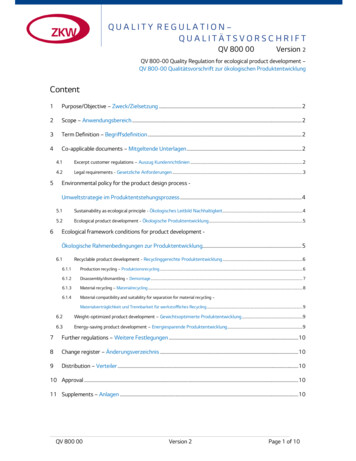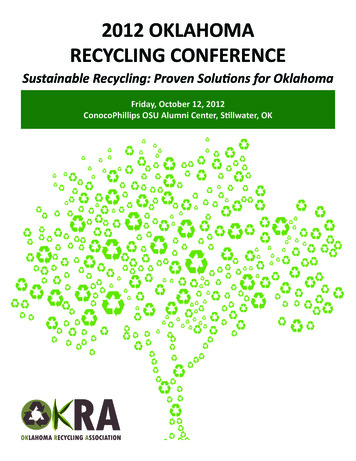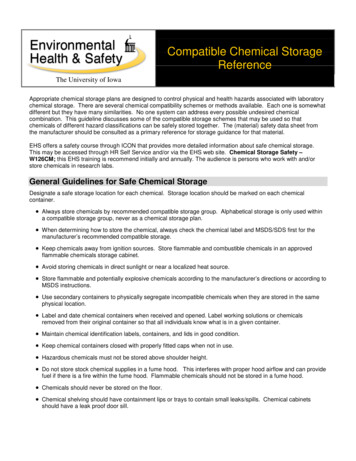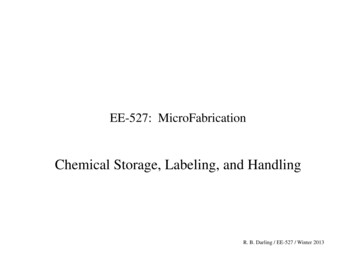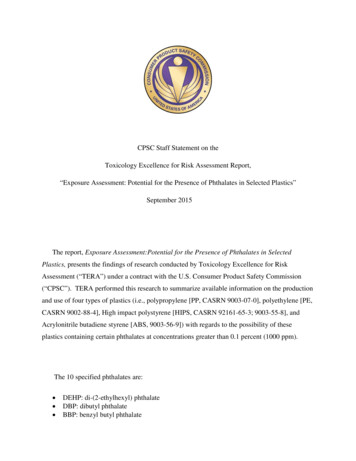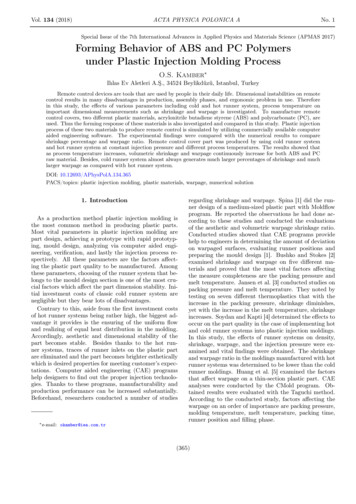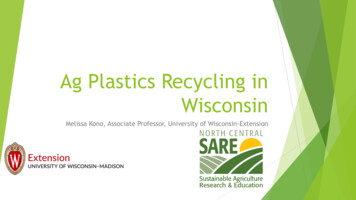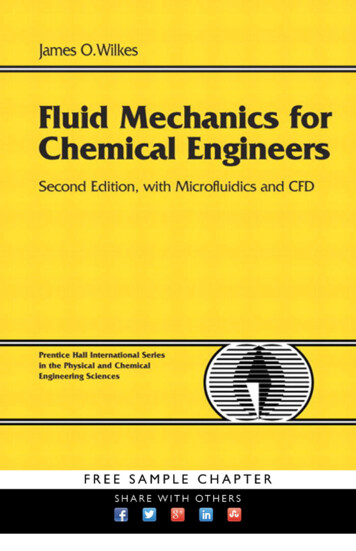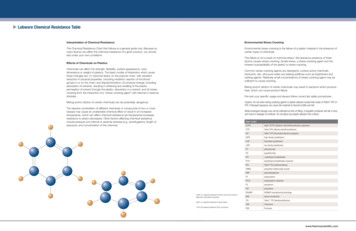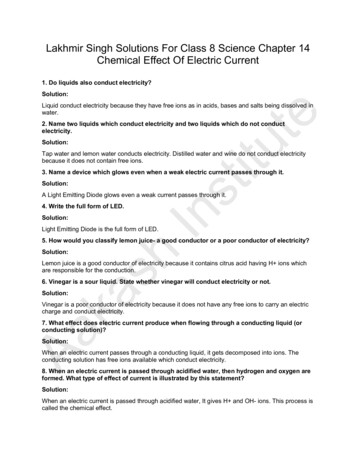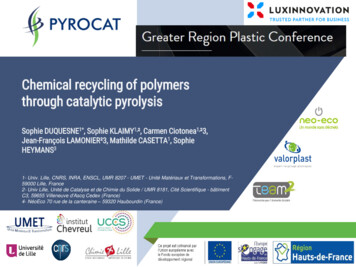
Transcription
Chemical recycling of polymersthrough catalytic pyrolysisSophie DUQUESNE1*, Sophie KLAIMY1,², Carmen Ciotonea1,²3,Jean-François LAMONIER²3, Mathilde CASETTA1, SophieHEYMANS31- Univ. Lille, CNRS, INRA, ENSCL, UMR 8207 - UMET - Unité Matériaux et Transformations, F59000 Lille, France2- Univ Lille, Unité de Catalyse et de Chimie du Solide / UMR 8181, Cité Scientifique - bâtimentC3, 59655 Villeneuve d'Ascq Cedex (France)4- NéoEco 70 rue de la canteraine – 59320 Haubourdin (France)
Plastic wastesPlastics production, plastic wastegeneration by industry and plastic wastetreatment by method in the EU, 2011Waste t-of-plastic-waste/
Recycling methodsEnvironnementalissuesDisposal to RecoveryPrimary Recycling contaminantslimit the applicationMechanical or Secondary Recycling sorting is neededChemical or Tertiary RecyclingSolvolysisPyrolysis3
What is pyrolysis?Environment-friendly process allowing the valorization of plastic waste bythermal degradation of polymers into smaller valuable moleculesPolyethylene (PE)PYROLYSISPolypropylene (PP)Polystirene (PS)350 C - 1350 CGas, Oil, Wax, ResiduePolyethyleneterephthalate (PET) Thermal degradation mechanism: very complexreaction of β-scissiors, isomerization, hydrogen transfer, oligomerization, DielsAlder additionDrawbacks: High temperature of process high energetically cost Low quality of products making this process unfeasible Very wide range of products complicated processes for separation4
Why catlytic icPyrolysisAcid Catalyst offer the possibility to orientate the degradation process !Carbonium IonCatalysisPyrolysisLess demand in energy-H2Acid CatalystLess impurities / selectivityCarbenium IonDecreasing the char residueProductsCatalyst : cost and recycling?Knowledge on the mechanism ofactionEconomic / environnemental impact ofthe 022Carbenium Ions promote:- charge isomerization- chain isomerization- hydride transfer- alkyl transfer- formation and breaking of C-C bond5
ContentQuantity andcomposition ofPyrolysis processesKey AspectsTemperatureResidencetimeCompositionof the wasteHeating rateCatalystsData fromModel mixture : 30% PP, 30% HDPE, 15% LDPE,10% PS, 15% PET GasesOilWaxCharData from6
Pyrolysis Unit Analysis usingFTIR Analysis usingGC/MS and GS/TCD1g of sample, 200mL/minGC-MS programCarrier gas: HeCarrier gas flow: 1ml/minInitial temperature/ initial time: 40 C/15minHeating rate: 0.5 C/minFinal temperature/ final time: 160 C/ 15minInjection temperature: 300 CInjection volume: split (10:1) split flow: 10ml/minTransfer line: 300 C7
Thermal Pyrolysis of Virgin Materials2 temperatures550 and 600 CDecreasing of the amount ofviscous liquid from 8 to 2% stronger cracking of C-C bondsDecreasing of the amount of waxfrom 25 to 4% stronger crackingof C-C bonds8070PPPP60PE easier degradation of50Increasing of the amount of liquid simple structure of PS4030No formation of liquid phase20100PP 550PP 600PE 550liquid%PE 600wax/viscous liquid%PS 550gas%PS 600residue%PET 550PET 6008
Composition of condensables in case of PE9 Large amount of aromatic compounds
Composition of condensables in case of PP Temperature aromatic compounds10
Effect of temperature on oil composition456040PP 550503530PE 6004025%%PE 550PP 600203020151010500C6C7C840C6C9 C10 C11 C12 C17 C18 C20 C22 C23 C25C10C11C12C13C17C20C23PET 550PET 60030252520%%C935PS 60030C840PS 55035C72015151010550C6C7C8C9 C10 C11 C12 C13 C14 C15 C16 C17 C180C6C7 Temperature number of C in thecondensable productsC8C9C10 C11 C12 C13 C14 C1511
Thermal pyrolysis of mixturesThermal pyrolysis of 50% PP 50% PE7066,5596040Number of carbon distribution33vs36505041vs4545%32302540PP PE 55035PP PE 6003016%20252010151,500PP PE 550Liquid%PP PE 600wax%gas%residue%01050C6C7C8C9 C10 C13 C14 C15 C16 C17 C18 C20 C2312
Thermal pyrolysis of mixturesThermal pyrolysis of the model mixture706050%407030602010500Liquid%%40Wax%MM 55030Gaz %Résidu%MM 6007020%10060MM 55050MM 60040302030% PP45% PE10% PS15% PETMM100C6C7C8C9 C10 C12 C13 C14 C16 C17 C22 C23 C2513
Literatur review - Acid catalyst used incatalytic pyrolysis of plastic wasteAcid catalyst: zeolites (ZSM-5, HY, Beta-Y, HNZ), mesoporous silica (MCM-41), clays, NiFe CNTsPYROLYSESampleZSM-5Penta-HZSM-5Süd Chemie CorporationZSM-5BP ChemicalsZSM-5GRACE-DavisonRatio Si/AlSBET(m2/g)Ref.Yield wt %Substrate/catalystTemperature( C)GasLiquidResidue22379PE/ 10 wt.%45088,410,90,735397PE/ 30 wt%45077,8822,12017391PE / 40 wt.%36094,211,264,53Lin et al.-341PE / 10 wt. %55070,718,30,5Marcilla et al.Catalyst parameters: Acidity, crystallite size, porosity sizePark et al.Mastral et al.14
Zeolites: ZSM-5 ; acidic materialsHydrates aluminosilicates with microporous and crystalline structure- type MFI (Mobile Five), formedby uniform tetrahedral units (Primary Building Unit, PBU)ZSM-5: Nan (H2O)16[AlnSi(96-n)O192]-MFI, avec n 27- orthorhombic symmetry structure, being composed of 96 tetrahedra defining a 3D network, includingstraight and sinusoidal interconnected channels- two diameters of pores : d1 5.1 Å , d2 5.5 Åview on a sinusoidal channel of MFIstraight and sinusoidalinterconnected channels of MFIZSM-5 with different parameters:Acidity: - ratio Si/Al 5 - can be obtained by direct synthesis;- post treatments : desilication or dealumination;Structural and morphological: - crystallite size- micro or mesoporosity15
Experimental part : h-ZSM-5Molar Composition:100 SiO2 : xAl2O3 : 30Na2O : 16 H2SO4 : 20 TPAOH : 4000 H2Ox 0.43; 0.77; 1.0; 2.30Crystallization:Washing: pH 8Filtration - with Buchner /centrifugationCalcination - 550 C for 8hIon exchange: h-ZSM-5Calcined Na-ZSM-5 was ion exchanged with 0,5 MNH4NO3, 70 C /6h ; filtrated, washed, dried (100 C/24h) and calcined.In this work: h-ZSM-5 was prepared having the ratio Si/Al 13, 25, 50 and 13016
Structural and morphologic analysis for hZSM-5X-ray diffraction Typical reflections associated to MFI structureh-ZSM-5 was successfully prepared No broad peaks at 2θ 20 to 25 well crystallized h-ZSM-517
Structural and morphologic analysis for hZSM-5N2- PhysisorptionSource : cm3/g)Si/Al 2702180.150.1152Si/Al 25Si/Al 50Si/Al 130 VP of 0,13 and 0,21 cm3/g and SBET of 185 and 294 cm2/gconfirms a well crystalized structure of the h-ZSM-518
Structural and morphologic analysis for hZSM-5RMN 27Al The presence of tetrahedral and octahedral Al isrevealed 90 % of [4]Al is into zeolite framework for all thesamplesSample% [4]Alfw% [5]Al% [6]AlbulkSi/Al 5092 /-508 /-3Si/Al 2589 /-5011 /-3Si/Al 1391 /-51 /-38 /-3The 27Al MAS-NMR experiments were performed at 208.5 MHz on a AVANCE III 18.8T spectrometerequipped with a 3.2 mm probehead operating at spinning frequencies of 20-22 kHz. The quantitative spectrawere acquired with a 1 ms pulse lenght, 512 transients and a recycle delay of 0.5 s. The [x]Al quantificationwas directly obtained by signal integration.1019
Acidity of h-ZSM-5FTIR-Py and TPD-NH3FTIR-Py –analyze the type of acidityTPD-NH3 –analyze the force of acidityTPD-NH3 Strong acid site are obtained for Si/Al ratio of 13 and 25Brønsted acidity: 50 25 13SampleAcidity (probe: NH3)(mmol/g)Acidity (probe: Pyridine)(mmol/g)ratio Brønsted / LewisSi/Al 131.831.21Si/Al 252.166.90Si/Al 501.804.53Si/Al 1300.10-1120
Catalytic pyrolysis of polyethylene60PE 550PE 450 - ZSM5Carbon number quid%wax%gas%residue%C6C7C8C9C10 C11 C12 C13 C17 C20 C35Catalytic Pyrolysis: High yield of liquid phase High decreasing of wax formation Strong Brönsted acidity of ZSM-5 zeolite has a great influence in aromatization reactions (C6-C9)21(1g de Polyethylene (PE) et 0,1g de ZSM-5 (Si/Al 13) (10 wt %), under N2 flow 200 mL/min)
Catalytic pyrolysis of MM at 550 ésidue%2,30,3% C6-C8:84% MM THERMAL 53% benzene toluene styreneCarbon number distribution4540MM-ZSM-53587% zsm-5 71%benzene toluene 6C17C22C2522
Conclusions Pyrolysis is a promising way to recycle plastic wastesAll h-ZSM-5 samples are showing MFI structure well crystallizedCatalytic Pyrolysis of Polyethylene is presenting high yields to liquid phase (40wt.%) compared to Thermal Pyrolysis (26 wt.%) and a high decreasing in waxformationStrong Brönsted acidity of ZSM-5 zeolite has a great influence in aromatizationreactions, the liquid phase is containing a majority of aromatic molecules23Source: RSC Adv., 2012, 2, 4844-4856; Catal. Sci. Technol., 2016,6, 5350-5363, http://aes.mines.edu/fbrpyrolysis.html, Environ. Sci.: Processes Impacts, 2015, 17, 1513-1521
Thank you for your attention!Acknowledgment to the Région Hauts deFrance for its financial support24
Chemical recycling of polymers through catalytic pyrolysis Sophie DUQUESNE1*, Sophie KLAIMY1,², Carmen Ciotonea1,²3, Jean-François LAMONIER²3, Mathilde CASETTA1, Sophie HEYMANS3 1- Univ. Lille, CNRS, INRA, ENSCL,
